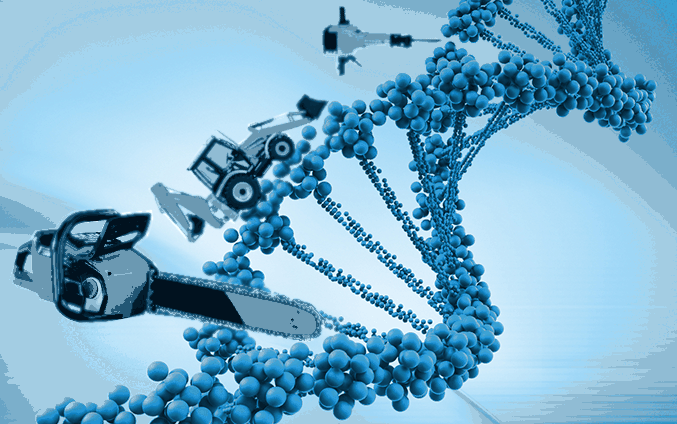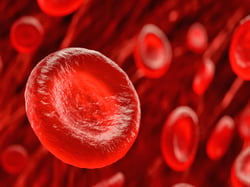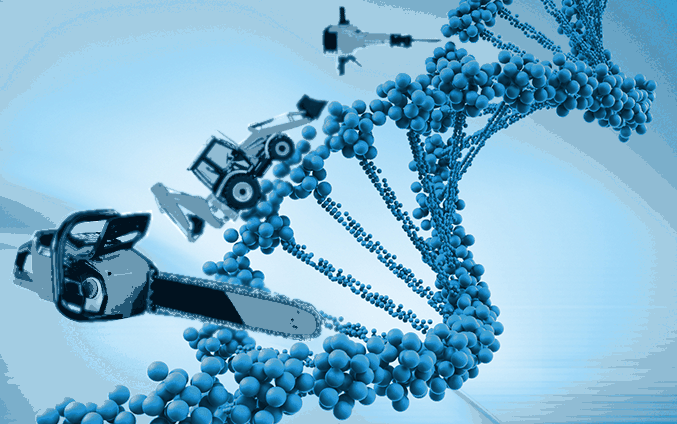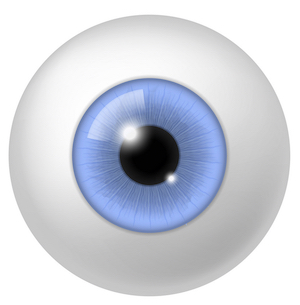Towards the end of my doctoral research, I first heard the rumblings of an acronym termed “CRISPR” that was starting to gather momentum. By the time I earned my doctorate, the applications that were discussed in both theory and in practice accelerated to the point that, while I didn’t fully understand the mechanism of the factors involved, I was certain that the discovery and re-engineering of this prokaryotic phenomenon would eventually be recognized with a Nobel Prize. Less than a decade after their first publications on the topic, 1, 2 Emmanuelle Charpentier and Jennifer Doudna were awarded the Nobel Prize in Chemistry “for the development of a method for genome editing,” which sounds a lot less important than it actually is!

Figure 1: Imagine being able to focus on a gene of interest and change it on a whim!
CRISPR: A Fortuitously Accidental Discovery
Originally discovered in prokaryotes, the clustered regularly interspaced short palindromic repeats (CRISPR) and CRISPR-associated (Cas) proteins were identified as a mechanism akin to RNA interference which acted like a form of adaptive immunity. 3, 4 In bacteria used to study this phenomenon, it was shown that gene sequences from invasive bacteriophages could be incorporated into the host genome with characteristic spacing nucleotide sequences, and once the actual mechanism involving a guide RNA and re-engineered Cas9 protein was described and further optimized, 1-4 the race was on to apply the surprisingly convenient genome editing technology to many fields of biology and health.
There have been huge advances in genetic engineering since the discovery of restriction endonucleases (another Nobel Prize winning achievement!), with similar methodologies used to knock out specific genes. The advent of CRISPR provides a much easier and more cost-effective method to not only knock out genes (something ABclonal employs regularly to validate our antibodies), but its flexibility also allows CRISPR to be used to directly edit a specific gene sequence. 5 In addition to the powerful gene editing application, CRISPR can also be applied using an engineered catalytically impaired Cas9 protein to effect epigenome editing and the study of chromatin structures. 5
The Dream of Gene Therapy
The past decade has seen the publication of thousands of journal articles dealing with the applications and improvements made to the CRISPR technology to address human health issues and our own scientific curiosities. Similarly to when RNA interference was first reported and just about every laboratory in the world started using short interfering RNA-based methods to knock down genes in their research, the use of CRISPR has exploded to the point where you would be surprised if there wasn’t at least one major article about CRISPR each week.
With such a dynamic and robust tool on hand, researchers have attempted to bring the dream of targeted gene therapy to fruition. 6, 7 For example, prevalent diseases that are associated with genetic mutations such as Parkinson’s disease are a focal point for CRISPR-based studies in an effort to design a treatment that could reduce and even reverse neurodegeneration. 6 Using CRISPR to target tumor cells while sparing normal tissues is one of the holy grails of biotechnology. 7 On a global level, using CRISPR technologies to enhance crop yields and quality have obvious benefits to the human condition. 7
Because humans enjoy their convenience, CRISPR has also been applied to some very unusual applications. A recent study suggested that it would be possible to create hypoallergenic pets, as a gene termed Fel d 1 can be efficiently edited out of a cat’s genome, and may be nonessential for the viability of the animal. 8 While these efforts are not as pressing as the treatment of genetic disorders, it is good to know that the tools are available should scientists choose to pursue them.
The Ethics and Ramifications of CRISPR
Although the broad application of CRISPR is underway and potential new avenues appear to be limitless, as with many discoveries and human interventions, the brakes need to be tapped while the effects of CRISPR are evaluated. As a famous example, the report that a Chinese scientist had genetically edited human babies was shocking as it brought into focus the ethical issues for such a huge step forward. CRISPR is also well reported for its off-target effects, and the manipulation of the target genes may have unknown consequences for cellular physiology given that we still don’t have a complete understanding of genomics and the interactions between genes and gene products. 6, 7, 9, 10

Figure 2: Scientists may not always consider the ethics of their research. (Jurassic Park, from Universal Pictures)
As we previously discussed, there are some unusual potential applications of CRISPR that involve the de-extinction of certain animals, such as the woolly mammoth. My first thought to this was that whoever thought about this had either never seen Jurassic Park or decided that wasn’t going to be a problem. (Figure 2) I was also reminded of one of the most notorious attempts by humans to control pests by the introduction of cane toads into Australia, where they have now essentially taken over the ecosystem. In the case of the “gene drive” approach to eradicating diseases and pests, there is a danger in whether the engineered alleles would spread rapidly and potentially affect the gene pool and the greater ecosystem in an unintended manner. 5
CRISPR in the Mainstream
The GATTACA-like dream of precisely targeting and repairing genetic defects has been realized for at least one class of diseases. For many people, defects in hemoglobin production could lead to serious health problems. These types of diseases include sickle cell anemia, where the hemoglobin has a point mutation that causes red blood cells to alter their structure, as well as beta thalassemia, where the blood cells just do not produce enough hemoglobin.
 A new therapy branded Casgevy is now available and has been approved in the United Kingdom as of November 2023 to tackle these blood conditions using CRISPR-Cas9 gene-editing technology. With promising results from clinical trials leading to its approval, this effective (but expensive) one-time treatment is an intravenous infusion of repaired hematopoietic stem cells. The edited cells are derived from the host's hematopoietic stem cells which have undergone CRISPR-Cas9 editing to stimulate the production of fetal hemoglobin through the disruption of the BCL11A gene. While Casgevy does not restore the original hemoglobin structure, this treatment strategy does produce enough viable red blood cells containing the fetal hemoglobin to boost oxygen circulation to the patient's tissues, with the alleviation of the most painful symptoms of the disease and minimal side effects. Shortly after approval in the UK, Casgevy was approved by the United States FDA in December 2023.
A new therapy branded Casgevy is now available and has been approved in the United Kingdom as of November 2023 to tackle these blood conditions using CRISPR-Cas9 gene-editing technology. With promising results from clinical trials leading to its approval, this effective (but expensive) one-time treatment is an intravenous infusion of repaired hematopoietic stem cells. The edited cells are derived from the host's hematopoietic stem cells which have undergone CRISPR-Cas9 editing to stimulate the production of fetal hemoglobin through the disruption of the BCL11A gene. While Casgevy does not restore the original hemoglobin structure, this treatment strategy does produce enough viable red blood cells containing the fetal hemoglobin to boost oxygen circulation to the patient's tissues, with the alleviation of the most painful symptoms of the disease and minimal side effects. Shortly after approval in the UK, Casgevy was approved by the United States FDA in December 2023.
As treatments like Casgevy become more prevalent and approved by the various medical regulatory boards around the world, continuous studies should be performed to ensure there are no off-target effects. Due to the complex nature of the treatment in preparation of patient cells and re-delivery, future research may rest on more efficient delivery systems, though making an over-the-counter CRISPR therapy might not ever be feasible nor advised. The additional problem is the high cost, estimated to be in the millions of dollars per patient. As with all therapies, although part of the goal is to make money, the overall goal to benefit humanity is to make the treatment safe, convenient, and affordable. As a proof of concept, Casgevy has provided the first two, now it's up to the pencil-pushers to work on the affordable bit.
With Great Power…
I won’t finish off the Spider-Man quote that you all know so well, but the fact remains that CRISPR is a generational and influential technology that requires further study to perfect the mechanism. In addition, there may need to be oversight from scientific agencies or the government to ensure that the mechanisms are not abused or weaponized. Even Jennifer Doudna herself has cautioned that we should proceed carefully with this powerful technology. It has been barely a decade since the first publications reported this exciting and still relatively new technology, and there is a long road ahead to see what human ingenuity can do to improve global health and standards of living. I am cautiously optimistic that humanity will advance these molecular tools responsibly.
References
- Deltcheva et al. (2011) “CRISPR RNA maturation by trans-encoded small RNA and host factor RNase III.” Nature 471(7340):602-607.
- Wiedneheft et al. (2011) “RNA-guided complex from a bacterial immune system enhances target recognition through seed sequence interactions.” PNAS 108(25):10092-10097.
- Guzmán et al. (2021) “Digging into the lesser-known aspects of CRISPR biology.” Int Microbiol 24(4):473-498.
- Jiang and Doudna (2017) “CRISPR-Cas9 Structures and Mechanisms.” Annual Review of Biophysics 46(1):505-529.
- Adli M (2018) “The CRISPR tool kit for genome editing and beyond.” Nature Communications 9:1911 (Epub).
- Mehmood et al. (2021) “Clustered regularly interspaced short palindromic repeats as an advanced treatment for Parkinson’s disease.” Brain Behav 11(8):e2280 (Epub).
- Nidhi et al. (2021) “Novel CRISPR-Cas Systems: An Updated Review of the Current Achievements, Applications, and Future Research Perspectives.” Int J Mol Sci 22(7):3327 (Epub).
- Brackett et al. (2022) “Evolutionary Biology and Gene Editing of Cat Allergen, Fel d 1.” The CRISPR Journal (Epub).
- Javaid and Choi (2021) “CRISPR/Cas System and Factors Affecting Its Precision and Efficiency.” Front Cell Dev Biol 9:761709 (Epub).
- Uddin et al. (2020) “CRISPR Gene Therapy: Applications, Limitations, and Implications for the Future.” Front Oncol (Epub).




